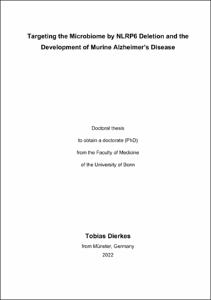Dierkes, Tobias: Targeting the Microbiome by NLRP6 Deletion and the Development of Murine Alzheimer’s Disease. - Bonn, 2022. - Dissertation, Rheinische Friedrich-Wilhelms-Universität Bonn.
Online-Ausgabe in bonndoc: https://nbn-resolving.org/urn:nbn:de:hbz:5-67266
Online-Ausgabe in bonndoc: https://nbn-resolving.org/urn:nbn:de:hbz:5-67266
@phdthesis{handle:20.500.11811/10047,
urn: https://nbn-resolving.org/urn:nbn:de:hbz:5-67266,
author = {{Tobias Dierkes}},
title = {Targeting the Microbiome by NLRP6 Deletion and the Development of Murine Alzheimer’s Disease},
school = {Rheinische Friedrich-Wilhelms-Universität Bonn},
year = 2022,
month = jul,
note = {Alzheimer's disease (AD) is an irreversible, progressive neurodegenerative brain disorder. The progression of AD is characterized by the deposition of amyloid-β peptides and hyperphosphorylated Tau proteins, causing loss of memory and cognitive skills. It is the most common human dementia and as such confers a huge emotional and economic burden on patients, caregivers and society. Environmental influences are thought to be the main cause for disease development, manifestation, and progression. And inflammatory molecules in the brain, such as pro-inflammatory cytokines, were discovered to participate in perpetuating molecular pathways driving neurodegeneration. Inflammatory processes can be triggered by pathogen-associated molecules as well as endogenous danger signals. A source of pathogen-associated molecules is the microbiota, which also emerged as a major component of human physiology and pathology, integrating influences from host genetics and environmental impact. Alterations in the composition and function of the microbiota have been recently highlighted to dramatically affect a number of neurological diseases, yet the mechanisms linking microbiota changes in the gut to distal CNS disorders remain poorly understood.
The aim of this study was to use NLRP6-deficient mice as a dysbiosis model to characterize dysbiosis development during AD and how innate immune control of the microbiota impacts AD disease development. The hemizygous double transgenic mouse model APP/PS1 was used as a well-established model system for human Alzheimer's disease. However, microbiome sequencing data from stool samples of all mice revealed strong fluctuations between each independent cohort. Suggesting that environmental variations in microbiota diversity and quantity masked the host’s NLRP6 dysbiosis phenotype. Under the given circumstances a combination of cognitive analysis, metagenomics and different experimental set ups to compare neuroinflammation and -degeneration in mice suggested almost no involvement of NLRP6 in AD development. The only statistical relevant finding was the increased expression of TLR2 on microglia, the immune cells of the brain, of NLRP6 deficient mice with APP/PS1 background compared to NLRP6 wild type mice with APP/PS1. The hypothesis that deciphering the inter-individual variability in microbiota composition and its impact on inflammatory processes involved in AD may hold the key to better understanding is still valid. This was supported by feeding mice a high fat diet which lead to variations in the gut microbiome and also induced an astonishing effect on the RNA transcripts of microglia. Ongoing studies and findings of this thesis might encourage future studies to develop strategies to target the microbiome by NLRP6 deletion and decipher NLRP6 modulated pathways in AD development.},
url = {https://hdl.handle.net/20.500.11811/10047}
}
urn: https://nbn-resolving.org/urn:nbn:de:hbz:5-67266,
author = {{Tobias Dierkes}},
title = {Targeting the Microbiome by NLRP6 Deletion and the Development of Murine Alzheimer’s Disease},
school = {Rheinische Friedrich-Wilhelms-Universität Bonn},
year = 2022,
month = jul,
note = {Alzheimer's disease (AD) is an irreversible, progressive neurodegenerative brain disorder. The progression of AD is characterized by the deposition of amyloid-β peptides and hyperphosphorylated Tau proteins, causing loss of memory and cognitive skills. It is the most common human dementia and as such confers a huge emotional and economic burden on patients, caregivers and society. Environmental influences are thought to be the main cause for disease development, manifestation, and progression. And inflammatory molecules in the brain, such as pro-inflammatory cytokines, were discovered to participate in perpetuating molecular pathways driving neurodegeneration. Inflammatory processes can be triggered by pathogen-associated molecules as well as endogenous danger signals. A source of pathogen-associated molecules is the microbiota, which also emerged as a major component of human physiology and pathology, integrating influences from host genetics and environmental impact. Alterations in the composition and function of the microbiota have been recently highlighted to dramatically affect a number of neurological diseases, yet the mechanisms linking microbiota changes in the gut to distal CNS disorders remain poorly understood.
The aim of this study was to use NLRP6-deficient mice as a dysbiosis model to characterize dysbiosis development during AD and how innate immune control of the microbiota impacts AD disease development. The hemizygous double transgenic mouse model APP/PS1 was used as a well-established model system for human Alzheimer's disease. However, microbiome sequencing data from stool samples of all mice revealed strong fluctuations between each independent cohort. Suggesting that environmental variations in microbiota diversity and quantity masked the host’s NLRP6 dysbiosis phenotype. Under the given circumstances a combination of cognitive analysis, metagenomics and different experimental set ups to compare neuroinflammation and -degeneration in mice suggested almost no involvement of NLRP6 in AD development. The only statistical relevant finding was the increased expression of TLR2 on microglia, the immune cells of the brain, of NLRP6 deficient mice with APP/PS1 background compared to NLRP6 wild type mice with APP/PS1. The hypothesis that deciphering the inter-individual variability in microbiota composition and its impact on inflammatory processes involved in AD may hold the key to better understanding is still valid. This was supported by feeding mice a high fat diet which lead to variations in the gut microbiome and also induced an astonishing effect on the RNA transcripts of microglia. Ongoing studies and findings of this thesis might encourage future studies to develop strategies to target the microbiome by NLRP6 deletion and decipher NLRP6 modulated pathways in AD development.},
url = {https://hdl.handle.net/20.500.11811/10047}
}






